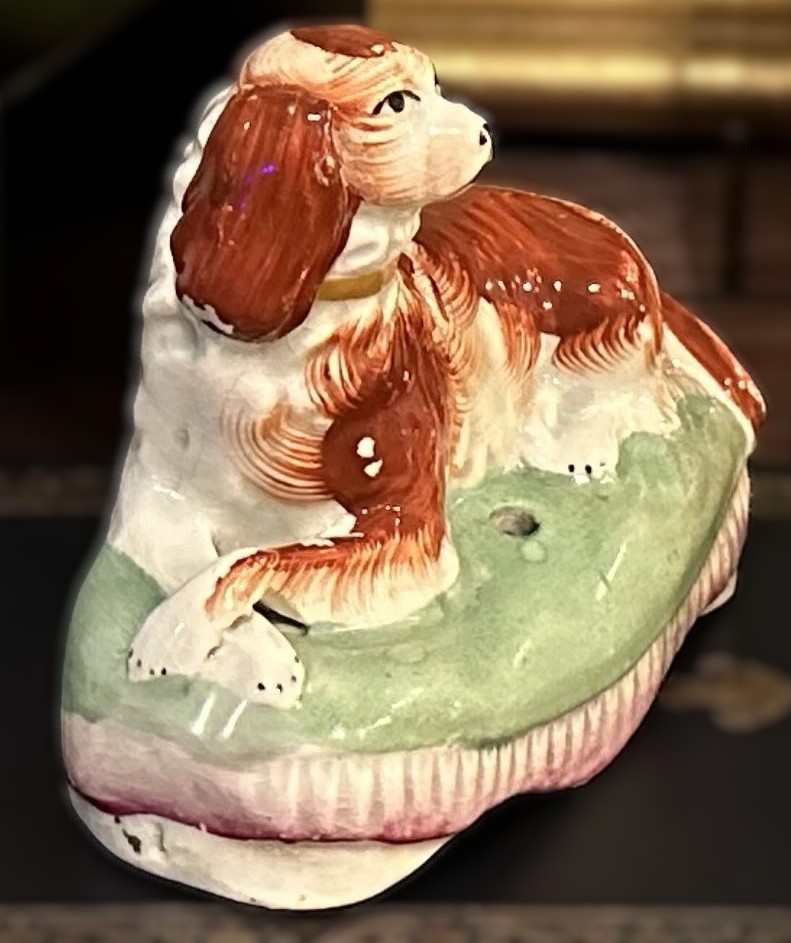
Staffordshire Pottery Spaniel Quill Holder
| Categories | Ceramics/Porcelain Figural, Figural - Animals & Living Creatures |
| Type | dog |
| Material | Pottery |
| Markings | Unmarked |
| Manufacturer | Staffordshire |
| Origin | England |
| Date or Era | circa 1850 |
| Measuring | 5 ¼” x 2 ½” x 4 ¼” high |
This Victorian-era Staffordshire spaniel dates from the mid-19th century (circa 1850–1875).
- Recumbent spaniel: A dog, modeled as a King Charles Spaniel, with russet (reddish-brown) markings and a characteristic downturned red mouth.
- Base: The dog rests on a shaped, oval green cushion with painted pink or gilt (gold) fringe or tassels.
- Function: It is a quill or pen holder. The function is indicated by the single aperture. This hole is specifically designed to hold a pen or quill upright when not in use.
Quill Holder vs. Inkwell
The difference between a quill holder and an inkwell is their function on a writing desk:
| Item | Function | Key Feature |
| Inkwell | A container to hold and preserve liquid ink for dipping a pen. | It has a reservoir (a hollow interior) that holds a volume of ink, usually with a lid to prevent spillage and evaporation. |
| Quill Holder | A stand or receptacle designed to keep a quill or dip pen upright when the writer is temporarily pausing. | It has holes or grooves to stabilize the pen’s shaft, but does not hold ink itself. |
Ink Use and Mechanism
This piece would not have been filled with ink and is not designed to function as an inkwell, though these are often sold as inkwells.
- The single, small hole on the spaniel’s cushion is too shallow and too high for a pen nib to reach and collect ink from a large internal reservoir. More importantly, it lacks a lid to prevent evaporation or a wide opening for easy filling, both of which are essential features of an inkwell.
- The hole is merely a stable slot for the pen’s shaft. The writer would have used a separate, dedicated inkwell and then placed the pen in the holder between writing sessions.
The confusion sometimes arises because inkstands (or standishes) were complex desk trays that often integrated an inkwell, a sand-shaker (pounce pot), and quill holders into a single large unit. Figurines like this one could be sold separately or as a component of a larger writing set.
Staffordshire Dogs, colloquially known as Comforters, were popular ceramic animal ornaments produced by Staffordshire potters in England starting in mid-19th century and often depicting Spaniels and other popular breeds such as Poodles, Greyhounds/Whippets, and Dalmatians. After Queen Victoria married Prince Albert in 1840, the family grew to include several dogs, but none were more popular than her favorite pet and constant companion, Dash, a King Charles Spaniel. This sparked a love for this breed. Early production Victorian Staffordshire dogs (1840s-1860s) are distinct from later productions (1870s-turn of the century) primarily in manufacturing techniques, quality of decoration, and overall craftsmanship. The transition from more rustic handmade pieces to factory produced models marks the most significant differences.
Sold for $500 in September 2025
Content disclaimer. The information posted is the owner’s best knowledge and may not have been vetted by the SOIC. We welcome comments, corrections, and additions, working to make our website information comprehensive and accurate.
Join the Society of Inkwell Collectors (SOIC) – it’s free!
Founded in 1981 as a non-profit organization,
we are documenting inkwells (and accessories).
We’re here to help and inform!













